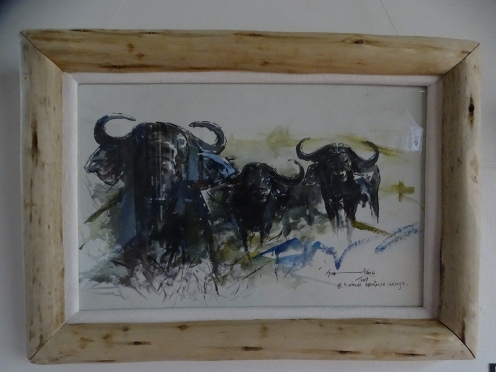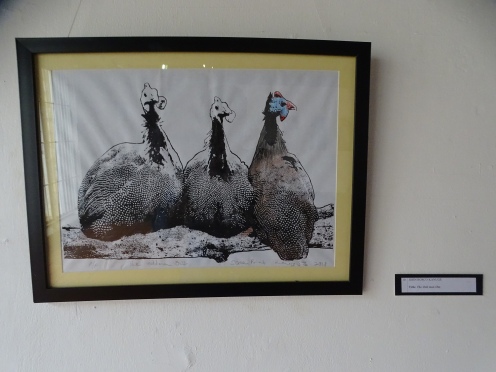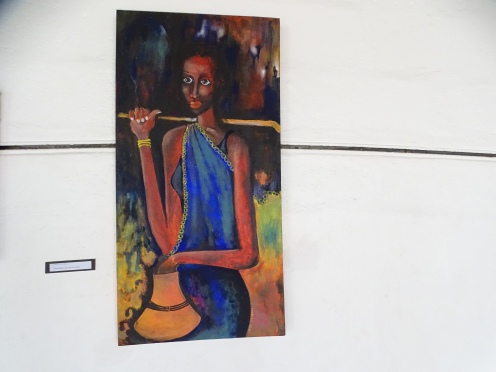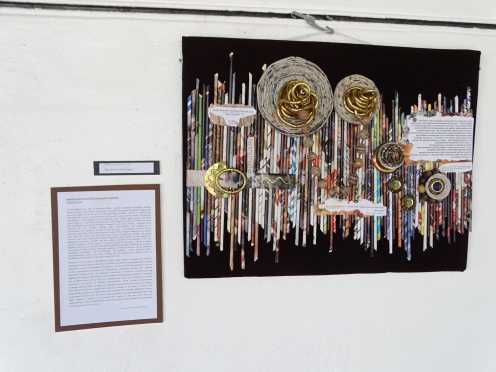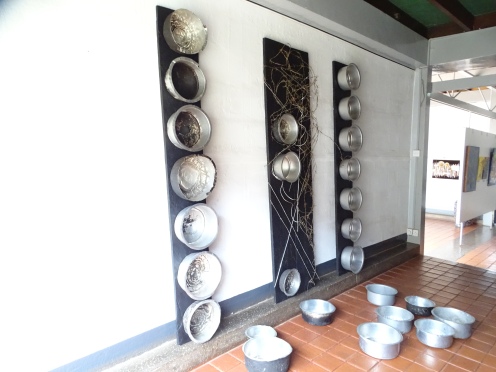The Embassy of Italy in Uganda, with the participation of the Ministry of Tourism,
Wildlife and Antiquities, organizes a photo-exhibition at Makerere Art Gallery on the
expeditions of Luigi Amedeo of Savoy-Aosta, Duke of the Abruzzi, a passionate
mountaineer and explorer of his time. He climbed the highest peaks of the “Mountains
of the moon”, the Rwenzori range, in 1906 marking the beginning of friendship between
Italy and Uganda. It will be the occasion to celebrate over a century of bi-lateral
relationship and a historical journey which combines research, exploration, tourism,
environment and cultural relations.
The Duke of the Abruzzi travelled to Uganda primarily to study the topography of
Rwenzori Mountains, but was profoundly attracted also by its geology, flora and fauna.
This expedition, documented by a detailed photographic report, consisted of 300
participants including photographer and fellow mountaineer Vittorio Sella, the
documenter who was developing the photos in a tent that worked as a dark room in the
mountains. Through Vittorio Sella’s pictures, the Duke of the Abruzzi offers a unique
view on authentic scenes of the Rwenzori range and Ugandan life as they were over a
hundred years ago.
The photo-exhibition shall be also the opportunity for discovering other extraordinary
adventures of Luigi Amedeo around the world: USA, Canada, North Pole, Pakistan
and Somalia. In 1897 he was the first on the top of Mount Saint Elias, located at the
border between USA and Canada, while in 1900 – during a two years expedition – he
almost reached the North Pole. After the exploration of the Rwenzori Range, in 1909 he
attempted the K2 mountain (Karakorum/Pakistan), where – even though the peak
remained unscaled – the Duke marked the highest altitude ever achieved by a man.
Finally, between 1928 and 1929 he explored the Wabi-Webi Shebeli River in Somalia.

This exhibition is curated by Independent curator Robinah Nansubuga.
The international Women’s Day is being celebrated each year on March 8.
To celebrate women’s day, we have selected Ignatius Sserulyos’ Sculpture piece as our art work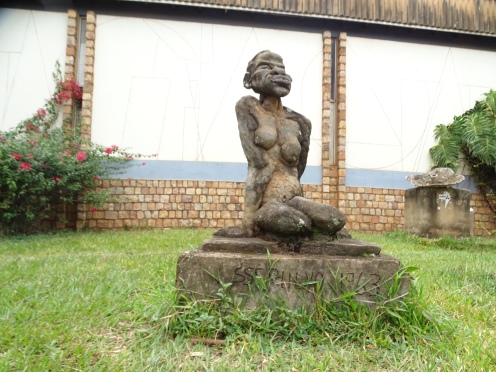 of the Month. We shall be discussing the artwork and talking about the artist.
of the Month. We shall be discussing the artwork and talking about the artist.
Ignatius Sserulyo
Born in 1936 in Masaka, Sserulyo was brought up as a Christian in a rural part of the Buganda region of southern Uganda. After his secondary education at St Mary’s College Kisubi, he joined Makerere School of Fine Art in 1961 where he studied painting and sculpture. He taught in several schools, before returning to Makerere Art School in 1969 to pursue a master’s degree in painting, which he completed in 1973.
Sserulyo’s passion for texture and modeling of colour spills over into sculpture. Produced in 1963 his cement figure Old Woman is conceived within the same essence of tactility and great attention for the subject. The subject itself, which places emphasis on old age, brings out all the physical problems that can affect an older person, while yet retaining dignity and pride.
Come and be part of this noble cause of History writing and documentation.
Hello our dear Followers,
Did you miss the official opening of Different But One 22, Are you unable to come physically to the Gallery,
Well, Attached are some of the works on display. The exhibition is still on going, closing on 15th March, 2018
OPENING THURSDAY 15TH FEBRUARY, 2018 at 5:30Pm
Makerere Art Gallery is hosting an annual exhibition, “Different But One”, happening the 22nd time. This is a display of a collection by Academics at Margaret Trowell School of Industrial and Fine arts, CEDAT, Makerere University. Lecturers of different backgrounds come together as a whole to display their new body of works and works in progress to inspire students and the public. This important exhibition is curated by Rebecca Uziel from Israel .
.
Makerere Art Gallery is hosting an exhibition “TABOO” A Swedish/Ugandan Gender Balance Project which was conducted in South-Western Uganda.
Bishozi Art Movement [BAM] is a group of Swedish and Ugandan artists working with fine art, sculpture, mosaic and music. Around 700 people from thirteen different Bishozi National Organization villages in South-Western Uganda participated in workshops centered on ‘gender balance’ conducted by BAM. The workshops have sparked discussions on gender norms and cultural traditions hence an Exhibition.
BAM has the pleasure to present a selection of the artwork created in the workshops in an installation at Makerere Art Gallery. The exhibition opens on the 2 February 2018 at 5pm.
BAM offers two days of workshops at Nkumba University, Entebbe, on 5 and 6 February 2018. Next BAM exhibition will take place in Sweden in April 2018.
BAM is supported by Bishozi National Organization (BNO), Bishozi International Program (BIP), the Swedish Arts Grants Committee, and Makerere University.
Participants include;
Annette Mirember Rosati, Fine Art, Sweden
Dr. Lilian Mary Nabulime, Sculpture, Uganda
Andrew Kivumbi, Mosaic, Uganda
Biggi Vinkeloe, Music, Sweden
Nema Vinkeloe, Music, Sweden
Find us on facebook: BIP, Bishozi International Program
Website: http://www.bishozi.com
OPENING: 15th December, 2017- 1st February 2018
Makerere University Institute of Heritage Conservation and Restoration is presenting the “Colours of Turkey, the Cradle of Civilizations” Exhibition. Turkey is the cradle of civilizations, a melting pot of cultures connecting Asia and Europe. She hosted a 12 thousand year history of humanity in her territory. Turkey has a splendid climate embracing four seasons together, and possesses a nature housing all tones of green and blue as well as all the colors. 13 great civilizations as well as historical and cultural values belonging to 3 religions exist in Turkey.
For thousands of years in the lands of Anatolia many different civilizations have come to life and have laid to rest eternally under the Anatolian earth. These are such civilizations as Hittites, Phrygians, Lydians, Ionians, Urartu, Persians, Byzantines, Macedonians, Romans, Turks. Many excavations have been carried out on these lands as layers upon layers of these civilizations have left behind breathtaking artifacts. These artifacts are in the shape of statues, mosaics, wall reliefs, pillars, mansions, churches etc.
Scholars have traced back the history of mosaics as back as the forth millenium BC to the Temple of Uruk in Mesopotamia, the time of the Sumerians which are a Turkish civilization from Central Asia, and the earliest known civilization on earth.
The show presents six remarkable artists from Turkey. The artworks on show comprise of paintings and photographs, these visually narrate the rich history and civilization of Turkey.
Sedef Yavuzalp is married to Ambassador Osman Yavuzalp and the mother of two boys. She graduated from the American College in Paris with a BA in International Affairs with the degree of “magna cum laude” in 1987. She received an MA from the Universite Libre de Bruxelles with a degree of “distinction” in international and strategic relations. Despite her busy work schedule as an Ambassador, she has reflected her love for art to her paint brush at every occasion since 2012. She is inspired by the rich and deep-rooted history and culture of Turkey as well as the history, culture and mythology of the East African region.
Mine Ülger married with 1 boy. She reflects her talent to the toile in Turkey and Uganda. Her paintings have been exhibited in various competitions. She was a student of very prominent Turkish painters in 1994.
Hasan Pekmezci was born in Konya, in 1945. He is married with 2 children. His teachers and art teachers discovered his talent in art. He passed the exams of Painting Seminar of Istanbul Çapa Teachers’ College in the first position, in 1965. Istanbul was an arts center during these years, too. Then, he worked at a little village school in Urfa.
ükran Pekmezci was born in Çankırı, in 1946. Her painting teacher in primary school guided her for painting. She passed the exams of Çapa Teachers College. She graduated in 1965 and became a primary school teacher in a village. In 1967, she entered İzmir Buca Education Institute Painting Department in the 1st place. She worked as a painting teacher in different schools in Turkey. After retirement, she has taught in the Atelier of Printmaking at Gazi University until 2000.
Hüseyin Yıldırım was born in Ankara in 1962, he graduated from Faculty of Training, Painting Teaching Program, Gazi University, in 1983. He served as a painting teacher at various secondary schools and Yunus Emre Training College in Eskişehir on 1985-1991.
Önder Aydın graduated from the Gazi Institute of Education in 1979 majoring in Art Teaching. Later he completed his Bachelor of Arts degree. He worked as an art teacher for many years. He painted children’s books. He is currently a member of the Association of Plastic Arts (PSD), the Ankara Contemporary Arts Foundation (CEGSAV) and a founding member of the Art Again Group.
We call upon you to come and be part of this wonderful visual trip to TURKEY.
”Beyond Fashion”
The fashion industry is increasingly becoming an important feature of Uganda’s’ social and political fabric legislation on dress code especially for civil servants has in the recent past become a topical issue. As a segment of cultural industry, fashion has moved from periphery to the center.
Fashion is more than promoting smartness and a positive image of ones self; fashion is at the forefront of enabling society get a deeper awareness of it self and its role in contributing to national development and identity.
In 1995, MTSIFA realized the importance of fashion. This led to its introduction in the curriculum. We are indeed taking fashion seriously as a medium that not only contributes to new knowledge but also help to raise the profile of Makerere University as an academic institution and also Uganda’s’ image internationally solid as a country respectful of its tradition inherited from the past, within a context of modern developments. Motifs from social life, culture, wild life etc form a solid base for fashion innovations at MTSIFA.
One of the key elements in the course of training fashion designers at MTSIFA is to show case fashion innovations through fashion shows. A course of fashion design would be incomplete without the inclusion of a fashion show.
”All the light we can see ” in an artists’ perspective
Enjoy an essay by Banga Simon.
This is Braille-and-Art: Illustration as a platform for the Blind to access public monuments in Kampala.
In September 2008, Uganda ratified the Convention on Rights of Persons with Disability. Consistent with this document, the government of Uganda has taken significant strides towards adopting laws and policies that guarantee the rights of the visually challenged to access public spaces.
However, this access has not been realized with respect to public culture and art. For example, all the monuments located in Kampala’s central business district are not accessible for the blind. It is for this reason that I produced the artworks I have put in this exhibition. I have raised a question as to whether Kampala’s monuments, that are visual in nature and thus inaccessible for the visually challenged, can be rendered accessible using illustration as a tool.
To address this question, I explored five monuments located within Kampala’s central business district. I purposively selected these monuments because they are important in the history of Uganda; they represent the trajectory of the country’s history. They include: the Independence Monument, the World War II Memorial, the Stride, the Centenary Park Monument and the Journey.
I have deployed my experience as a professional illustrator. I usually create illustrations focusing on images that communicate messages. I have observed that to achieve this objective, I have had to produce illustrations in two ways: (i) illustrations that done using simple line work with flat color imaging; and (ii) illustrations that done using well developed forms enhanced with attributes of traditional drawing.
I have used these two modes of illustration to inquire into the nature of the meanings attributed to reality especially with respect images made accessible to the visually challenged. I have learnt certain new things in the process:
First, Gábor Üveges (2007) is convinced that mastering traditional drawing techniques allows one to depict ideas about forms in a visual language and, in so doing, one avoids the problems of being ambiguous and long-winded that comes with verbal communication. In this exhibition I integrated traditional drawing techniques through illustration and transformed sculptures into forms that are not ambiguous and winded. This directness of message was important to render public monuments in Kampala’s central business district accessible for the visually challenged.
Second, Durand (2001) observed that expressiveness, precision, and simplicity underscore the broad appeal in drawing while the versatile role of strokes conveys form, tone, shape, texture and style that derive from both the richness and the difficulty of the medium. In this exhibition I have explored these attributes to produce my artworks.
It is against this background that I transcribed Kampala’s public monuments into forms that can be accessed by the visually challenged. My project was part of a bigger project titled Kampala’s Public Monuments/Allegories of Exclusion: Perspectives of Governance, Human Rights and Development. I started the process by looking at selected monuments as aesthetic objects: the fine arts. To achieve this, I experimented with different materials, surfaces, and tools ranging from the camera, pencils, pen and ink, charcoal pencils, colored pencils, crayons, water color, bond paper and scrambled paper to produce fine art.
Later, I re-directed my energy to experiment with textures targeting the aesthetic tastes of a visually challenged audience. I interrogated illustration as a way of transcribing selected monuments into tactile representations. I produced a kind of ‘brailled art’.
The artworks in this exhibition cover this whole process. Some of the works were done using traditional art media. Others were developed using the stylus, Perkins Braille machine, thermoform machine and computer software as tools to create Kampala’s public monuments in braille. I also used different materials including threads, bond paper, banana fibers, paper mash, bee/ paraffin wax, paper mash, style form and egg shells to achieve different textures and tactile effects. In the process, I expanded the scope of my illustration beyond traditional methods and techniques. I produced monuments that I discussed with a purposively selected visually impaired audience at Humura Hotel on 21-22 May 2017. I used examined the information I obtained from this discussion to produce more work which I presented for examination before I graduated with an MA(Fine Art) in January 2017. This exhibition thus also serves to celebrate my career and personal development.
Let me now say this in conclusion: as artists we can produce images that allow us to step outside our own reality and experience another time, place or people. By using illustration as a tool to render Kampala’s public monuments accessible for the visually challenged we can widen the possibilities of this experience. We can move from our comfort zone and experience the challenges faced by Persons with Disability as they struggle to access the art we make and place in public spaces. That way we can find ways of resolving such challenges of access as we widen the scope of Uganda’s contemporary art to include audiences whose aesthetic tastes do not primarily depend on the visuality of art.
REFERENCES
Ayoubi, Lida. 2011. “Human Rights Perspectives on Access of the Blind, Visually Impaired and Other Reading Disabled Persons to Copyrighted Materials.” Master´s Programme in International Human Rights Law and Intellectual Property Law, Faculty of Law, Lund University.
Cutsforth, Thomas Darl. 1951. The blind in school and society: A psychological study: American Foundation for the Blind.
Department of International Development. 2013. Disability in Uganda.
Farahani, Mukisa. 2015. “Museveni gives away Nakivubo.” Daily Monitor, 30 March. http://www.monitor.co.ug/News/National/Museveni-gives-away-Nakivubo/688334-2669914-vebm4e/index.html.
Groce, Nora, and JF Trani. 2011. “Disability and the Millennium Development Goals.” United Nations Publication.
Nyombi, Chrispas, and Moses Wasswa Mulimira. 2012. “The Rights of Persons with Disabilities: A Review of Employment Laws in Uganda.”
Tamale, Sylvia. 2004. “Introducing Quotas: Discourse and Legal Reform in Uganda.” The Implementation of Quotas: African Experiences, Johannesburg: International Institute for Democracy and Electoral Assistance:38-45.
AN EXHIBITION OF ARTWORKS IN WHICH PUBLIC MONUMENTS IN KAMPALA HAVE BEEN RENDERED ACCESSIBLE FOR PERSONS WITH DISABILITY.
27 OCTOBER – 15 NOVEMBER 2017,
Opening at 5pm.
Makerere Institute of Heritage Research and Conservation is presenting the All the Light We Can See Exhibition curated by Angelo Kakande. The show presents works done under the project entitled Kampala’s Public Monuments/Allegories of Exclusion: Perspectives of Governance, Human Rights and Development. Funded by the Carnegie Corporation of New York, this project unfolded a research agenda through which selected national monuments were rendered accessible to the persons with disabilities (PWDs). Being part of this research project, Simon Banga (a graduate student from CEDAT), Lodovic Frank Ssentamu and Ernest Mukwaya (undergraduate students of architecture from CEDAT) produced work on devising ways of rendering Uganda’s public art accessible to PWDs. The exhibition showcases interventions through which art, art history, disability studies, culture, policy and the law interact to widen the audience of Uganda’s contemporary art.
 Sculptures Exhibition by:
Sculptures Exhibition by:
Dr Lilian Mary Nabulime – 2017 Opening: 7th September at 5pm
Young women have higher opportunities to join the university and if well mentored do develop an idealized conception of becoming a successful women in the future. Obtaining a University degree highly sets them a foundation to success in life. Many African women grow up in cultures where marriage and motherhood are emphasized as the primary goals in life. Thus it is important to have role models or female mentors who embody academic achievement. Dr. J. K. Aggrey, mentioned that, “if you educate a man you educate an individual, but ifyou educate a woman you educate a nation.” Thus Luke (2001) claims that: to deny women the structural and ideological support they need to obtain full support and equal access, participation, and share of the rewards in the professions of their choice is to deny and impoverish society as a whole. The Task Force on Higher Education and Society (2000) reveals that disadvantaged groups, whether they are racial,linguistic, or religious groups in specific societies, or women almost everywhere, find it difficult to compete in higher education. They usually receive inadequate primary and secondary schooling making thus further progress in the educational system much harder to achieve.
My idea to develop the sculpture was motivated by Dr. J. K. Aggrey’s quotation. Since Makerere University campus is one the highest institute of learning in Uganda, I wondered what thoughts the girls have regarding encounters and privileges they have at the University. I usually observe some of the girls as I teach and mentor them. A few of them pass by office and we have a chat which ranges on various issues namely academics, social, religion, challenges and accomplishment. This steered me to assess their views on Womanhood and develop sculptures that reflected their beliefs,
Sculptures on Display
My earlier exhibition in 2015-16 was titled “Art in Open Office” held at KfW Office Kampala. The concept was to develop work for the “office”. In this exhibition am returning to my passion for found objects in wood and other materials like the nuts and aluminum cans. The wood was not over worked as I allow it to retain roughness and its natural forms and color. I usually beautify the sculpture with colour, burn the wood, strengthen/decorate it with metal sheets of aluminum or copper. The additions and reductions exposes/highlights hidden forms and usually the human forms have lips that are colored with bright red that draws the viewers.
This exhibition’s concept explores selected celebrated thoughts on woman hood and HIV/AIDS as the most affected are the youth and women (UNAIDS 2017). The techniques used in this exhibition differ. The girls have neither been adorned with bright coloured lips nor the forms of the sculptures enhanced with colours. The sculptures have been left with their natural colours with the aim to reflect the thoughts of the campus girls.
The sculptures are in 6 series: Fifteen miniature fired clay portraits with in 6.5×3.5×3 inches tilted “Expressionism”. The second group consists of fifteen found wood sculptures with in 60x30x30cm, titled, “Uniqueness of campus girls”. The third group has ten flat reliefs of 8x8inches, titled “Dreams and consequences” the fourth group are ten wood relief with nailed aluminum cans and metal nuts of 2x1xfeetx1inch, titled “Campus girls life styles”. The fifth group is big sculptures ranging from 1meter high titled “Reflections”. The last series is a conceptual sculpture of mixed media titled, “Wildness”. The sculpture will reflect on the freedom the campus girls have and yet if misused lead to un desired consequences.



